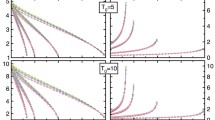Abstract
Thermal transport coefficients are independent of the specific microscopic expression for the energy density and current from which they can be derived through the Green–Kubo formula. We discuss this independence in terms of a kind of gauge invariance resulting from energy conservation and extensivity, and demonstrate it numerically for a Lennard-Jones fluid, where different forms of the microscopic energy density lead to different time correlation functions for the heat flux, all of them, however, resulting in the same value for the thermal conductivity.



Similar content being viewed by others
References
M.S. Green, J. Chem. Phys. 22, 398 (1954)
R. Kubo, J. Phys. Soc. Jpn. 12, 570 (1957)
L.P. Kadanoff, P.C. Martin, Ann. Phys. 24, 419 (1963)
D. Forster, Hydrodynamic Fluctuations, Broken Symmetry, and Correlation Functions (Benjamin, Reading, 1975)
A. Marcolongo, P. Umari, S. Baroni, Nat. Phys. 12, 80–84 (2015). doi:10.1038/nphys3509
J.-P. Hansen, I.R. McDonald, Theory of Simple Liquids, 3rd edn. (Elsevier, Philadelphia, 2006)
Y. Lee, R. Biswas, C. Soukoulis, C. Wang, C. Chan, K.M. Ho, Phys. Rev. B 43, 6573 (1991)
A. Marcolongo, SISSA Ph.D. Thesis, http://cm.sissa.it/thesis/2014/marcolongo
S. Plimpton, CMD simulations have been performed using the LAMMPS code, J. Comp. Phys. 117, 1 (1995), http://lammps.sandia.gov
R. Resta, D. Vanderbilt, Top. Appl. Phys. 105, 31 (2007)
Author information
Authors and Affiliations
Corresponding author
Additional information
This paper is dedicated to our friend and distinguished colleague Flavio Toigo, a long-time enthusiast of hydrodynamic fluctuations, on the occasion of his seventieth birthday.
Appendix
Appendix
In order to derive Eq. (19) from Eq. (14), let us first compute the time derivative of Eq. (13) using the definition of the atomic energies, Eq. (2), to obtain:
where \(\nabla \delta \) is the gradient of the \(\delta \) function. We now insert Eq. (16) into Eq. (14), to obtain:
where \(\mathbf {F}_{I}=M_{I}\dot{\mathbf {V}}_{I}\) is the force acting on the I-th atom and \(\mathbf {F}_{JI}=-\frac{\partial \epsilon _{I}}{\partial \mathbf {R}_{J}}\). Eq. (17) is not well defined in periodic boundary conditions because the position of the I-th atom, \(\mathbf {R}_I\), is defined modulo a vector in the Bravais lattice and depends on the choice of the origin of the unit cell. In order to write a well-defined expression for the current, we first note that \(\mathbf {F}_{I} = \sum _{J}\mathbf {F}_{IJ}\). Inserting this relation into Eq. (17), one obtains:
Now in the second term of the second sum in Eq. (18) we can interchange the IJ dummy indices, to obtain:
Eq. (19) is well defined in periodic boundary conditions, because it depends on atomic positions only through differences between pairs of them. Note that this derivation does not depend on the assumption that atoms interact through pair potentials, and it holds in fact for general many-body inter-atomic potentials [7]. When atoms interact through pair potentials, as it is the case considered in the present paper, and adopting the standard definition for the atomic energies, Eq. (2), one has \(\mathbf {F}_{IJ} = \frac{1}{2}\bigl ( \delta _{IJ} \mathbf {F}_I - \nabla _I v(|\mathbf {R}_I - \mathbf {R}_J|) \bigr )\), where \(\nabla _I\) indicates the gradient with respect to the position of the I-th atom. Throwing this expression into Eq. (19), one finally obtains Eq. (3) used in the text. Similarly, one would obtain the modified energy flux of Eq. (5) from the definition for the atomic energies given in Eq. (4).
Rights and permissions
About this article
Cite this article
Ercole, L., Marcolongo, A., Umari, P. et al. Gauge Invariance of Thermal Transport Coefficients. J Low Temp Phys 185, 79–86 (2016). https://doi.org/10.1007/s10909-016-1617-6
Received:
Accepted:
Published:
Issue Date:
DOI: https://doi.org/10.1007/s10909-016-1617-6




